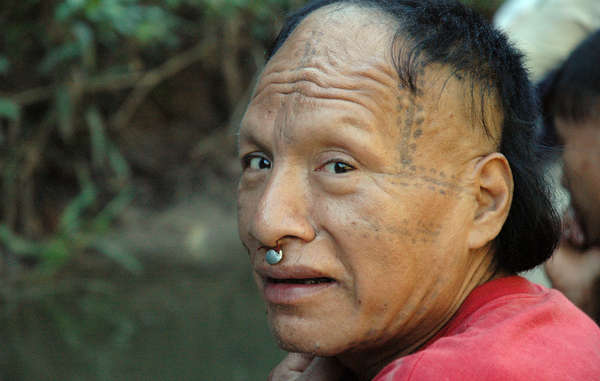
by Deep Green Resistance News Service | Jan 29, 2018 | Colonialism & Conquest
Featured image: Tomas was contacted between 2001 to 2003 and now lives in the Amazon region where one of the deadliest roads has been proposed. © David Hill/Survival International
by Survival International
Peru has approved a law that could devastate several uncontacted Amazon tribes.
The law declares “in the national interest” the construction of roads in the remote Ucayali region that borders Peru and Brazil.
The area lies inside the Uncontacted Frontier, home of the highest concentration of uncontacted tribes on Earth.
Several illegal roads that cut through uncontacted Indians’ lands have already been opened up. Thousands of illegal gold miners operate in the region, and have polluted dozens of rivers with mercury.
Uncontacted tribes face catastrophe unless their land is protected. They have the right to their land under Peruvian and international law.
Road building in the Amazon almost always leads to a devastating influx of settlers, loggers and ranchers.
Pope Francis, speaking from the region just days before the road law was passed, said: “Never before has there been a greater threat to indigenous peoples’ lands.
“We must break with the historical paradigm that sees the Amazon as an inexhaustible resource for other countries, without taking into account its inhabitants.”
Survival is calling on the Peruvian government to scrap road building plans inside the Uncontacted Frontier.
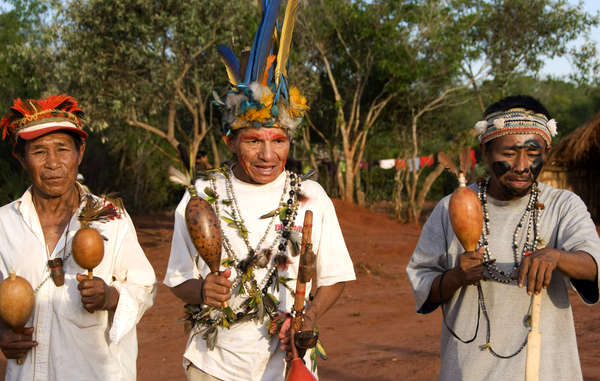
by Deep Green Resistance News Service | Dec 26, 2017 | Colonialism & Conquest
Featured image: The Guarani continue fighting for their land rights despite continuous attacks. © Fiona Watson/Survival International
by Survival International
Ten years ago the Brazilian government signed a landmark agreement with the Guarani tribe, which obliged it to identify all their ancestral lands.
The core objective of the agreement, which was drawn up by the public prosecutors office, was to speed up the recognition of the Guarani’s land rights in the southern state of Mato Grosso do Sul.
However, one decade on, most surveys have not even been carried out and the authorities’ failure to recognize the Guarani’s land rights continues to have a terrible impact on the tribe’s health and well-being.
With no immediate hope of recovering their land and rebuilding their livelihoods, thousands of Guarani are trapped in overcrowded reservations where the prosecutors say there is so little land that “social economic and cultural life is impossible.”
Other Guarani communities live along busy highways or on fragments of their ancestral land, hemmed in by vast sugar cane and soya plantations. They cannot plant, fish or hunt and have no access to clean water.
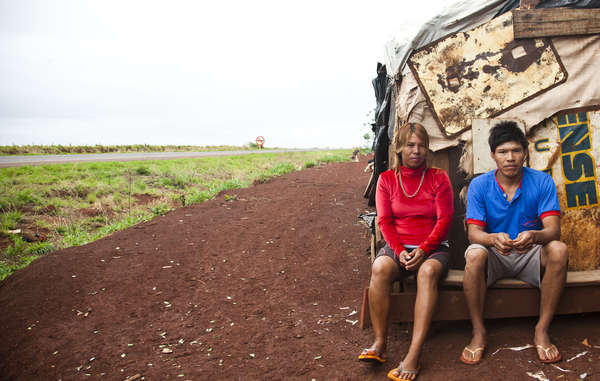
A Guarani-Kaiowa couple sit outside their makeshift roadside settlement of the Apy Ka’y community, near Dourados, Mato Grosso do Sul, Brazil. © Paul Patrick Borhaug/Survival
Health workers report that these communities are suffering from severe side effects of pesticides used by agribusiness. Some communities say their water resources and houses are deliberately sprayed by the ranchers.
A recent study estimated that 3% of the indigenous population in the state could be poisoned by pesticides, some of which are banned in the EU.
Malnutrition especially among babies and young children is common. According to Gilmar Guarani: “Children cry and cannot put up with this situation any more. They are really suffering and are very weak. They are practically eating earth. It’s desperate.”
Mato Grosso do Sul is home to the second largest indigenous population in Brazil, with 70,000 Indians belonging to seven tribes.
Much of their ancestral land has been stolen from them by cattle ranchers and agribusiness, and now they occupy a mere 0.2 % of the state.
John Nara Gomes says: “Today the life of a cow is worth more than that of an indigenous child… The cows are well fed and the children are starving. Before we were free to hunt, fish and gather fruits. Today we are shot by gunmen.”
The despair among the Guarani at the loss of their lands and self sufficient life is reflected in extremely high rates of suicide . In the period 2000-2015 there were 752 suicides. Statistics collected since 1996 reveal a rate that is 21 times greater than the national one. This is probably under-estimated as many suicides are not reported.
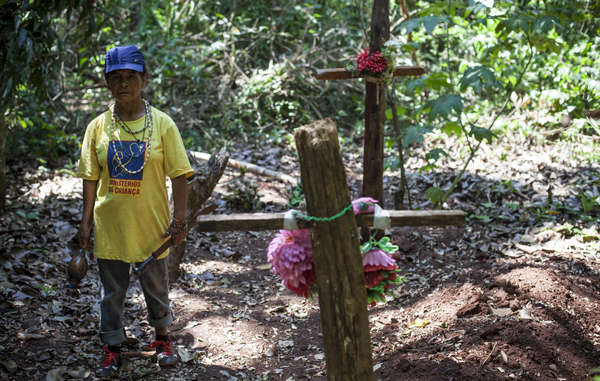
Damiana Cavanha, leader of the Apy Ka’y community, has seen the deaths of three of her children and her husband. She is determinedly planning a reoccupation of their ancestral land where they are buried. © Paul Patrick Borhaug/Survival
The Guarani also face high levels of violence and are constantly targeted by ranchers’ gunmen whenever they attempt to take back parts of their ancestral land. Recent data shows that 60% of all the assassinations of indigenous people in Brazil occurred in Mato Grosso do Sul state.
With a government and congress dominated by the powerful agribusiness sector, the landowners in Mato Grosso do Sul will not cede an inch. Many have resorted to the courts as a delaying tactic, to challenge the identification of Guarani territories. One core Guarani territory has had 57 legal challenges.
Despite this bleak scenario many Guarani vow to fight on: “Brazil was always our land. The hope that feeds me is that our land will be recognized, for without it we cannot care for nature and feed ourselves. We shall fight and die for it” says Geniana Barbosa, a young Guarani woman.
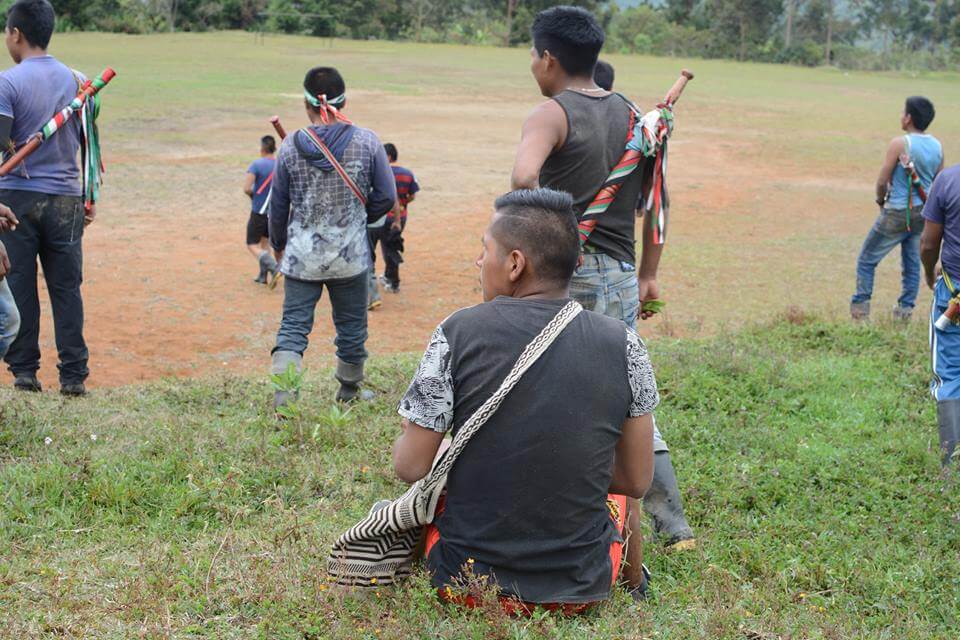
by Deep Green Resistance News Service | Dec 12, 2017 | Indigenous Autonomy
All images by Robin Llewellyn
by Robin Llewellyn / Intercontinental Cry
Colombian President Juan Manuel Santos may have received the Nobel Peace Prize, but peace has not come to Colombia. Social leaders and members of indigenous communities have been targeted in a wave of assassinations that has swept through the countryside during this supposed “post-conflict” era–and the state has failed both to stem the killings and to curtail the spread of illegal mining and drug trafficking.
Indigenous guards are elected by their communities and mandated to protect Indigenous lives and territory without the use of arms. Throughout both the civil war and the undeclared battle for territory and resources that has followed it–and carrying only the staffs that serve as their mandate of office–Indigenous Guards have been killed by non-state armed groups of the left and the right, by the forces of the state, and by mafias unaligned to political ideologies. Yet they have also succeeded in arresting heavily armed opponents and submitting them to the justice systems of indigenous territories and the state.
Today new challenges arise as communities consider whether Indigenous Guards should be paid and become professionals, and whether or how they should integrate their function with that of the Colombian police.
No region of Colombia has been more affected by the newest wave of assassinations than the department of Cauca in the southwest. The reservation of Juan Tama lies on the border of Cauca and Huila departments, high up in the Sierra Central. Juan Tama contains a training ground where Indigenous Guards from Nasa, Misak, and Yanakona communities regularly meet to challenge each other and themselves.
Intercontinental Cry recently had the opportunity to visit Juan Tama during one of these spirited competitions.


Indigenous guards gather for the meeting that precedes the race.

Over the course of one single day, teams of indigenous guards must go through an obstacle course that has to be completed while racing against the clock. This particular event saw a competition between Nasa, Yanakona and Misak reservations from across Cauca and Huila.

“Guardia!” In advance of the race the indigenous guards come together, forming lines for each participating reservation, that meet in the center to form a star shape. The responsibilities and values of the Guardia are pronounced, and the aims of the competition clarified. This event saw a competition between reservations from across Cauca and Huila, including reservations of the Nasa, Yanakona and Misak peoples. All Photos by Robin Llewellyn

The obstacle sees regular competitions with indigenous guards from several reservations taking the opportunity to improve their teamwork and strength.

Guards practicing on the assault course before the competition.



Children play on the assault course as guards practice before the competition.

An Indigenous Guard takes his time completing an obstacle. When racing against the clock, it becomes much more difficult.
The life of an indigenous guard is not for the faint of heart. It comes with great personal risk and an even greater responsibility, as Fredy Chikangana, a poet and ‘Amauta’ (An Amauta is a Qechua word translated to mean, “messenger from the ancestral knowledge of the Yanakona People”) from the Yanakona reservation of Rioblanco, would tell us in a later interview.
Fredy Chikangana told us that, “[B]eing an indigenous guard is a great responsibility in terms of the community and the territory. It is not just a matter of carrying the staff of office without commitment: there is a mission and it has to do with culture, with maintaining harmony in the community and maintaining harmony with Mother Earth.”
“To be an indigenous guard is a question of knowing to accompany the good work of the indigenous authorities, but if an authority fails, one also has to remember one’s ultimate obligation.”

The first team that raced against the clock. This particular obstacle consists of barbed wire strung between posts.
“The ancestors had various names for the indigenous guards of their day,” Fredy explained. For instance, there is ‘Aukaruna’ which is the Qechua word for a warrior, and ‘Aukas’ who were the vigilant beings of the forests.”
“To be a good indigenous guard one needs to have physical and mental readiness. It’s not just strength, it’s also the capacity to solve problems for the wellbeing (“buen vivir”) of the community.


A good indigenous guard also understands their culture–and they “[know] how to look at different approaches to be able to help their community.”
“He or she who is an indigenous guard must above all have caution and respect for the other, but also decisiveness when one has to act to defend the territory and the community,” he continued. “There are male and female indigenous guards in the same way there is the moon and the sun. Everyone knows how to enter a dialogue with their own gender, but in defense of the land, culture, and Mother Earth all are equal and act as if woven together.”
“To be an indigenous guard is to narrate between generations, to protect the rights of all.”

Balance, athleticism, and dedication are developed throughout the course: this obstacle is only ruled completed when the guard lands and launches in one movement into a forward role through mud.

Belsi Rivera is an indigenous guard in the Nasa reservation of Nasa Kiwe. She took part in the struggle for control of the Cerro de Berlin Mountain in Toribio, Cauca, that was occupied by the army. She also works with children for the educational institute of Nasa Kiwe.
Belsi told us, “The Nasa People have a history of struggle and resistance that is based in love for Mother Earth; she is the fount of energy because according to our cosmogony we are part of her and we see her reflected in our authorities such as our governors and our indigenous guards, and more specifically in the staffs of office that are carved from chonta wood that symbolizes both territory and legitimate authority. The staffs are bound by three hoops, each symbolizing a realm within our world-view.”
“The first realm is that of above, where the ‘sxaw’, the great spirits, live. The second is the middle realm where the animals and trees share the territory of the Nasas (known as the people who are children of water and the stars). The third realm is that of below, where water lies hidden and where minerals exist and must remain.”
“There were times in the past when the people struggled against the colonists who had come to evict and assassinate us, and we took up arms to defend ourselves,” Belsi continued. “This negatively affected our ideas and our respect for life, so we renounced arms and looked again to restore equilibrium. The struggles continued with the great idea of protecting our Mother Earth, and gradually we developed the idea that there needed to be people solely dedicated to being protectors, even though all people can and should pursue such goals. The ‘kiwe thegnas’ or indigenous guards have the permanent responsibility of establishing control and protection of the territory and of defending life and our Mother Earth.”

Another team races to complete the exercise.
“The indigenous guard is very involved in protecting the community when it seeks to liberate Mother Earth from the mono-cultivation of sugar and pine plantations, and to return that land to the community which was stolen from our ancestors. When we speak of the Liberation of Mother Earth, many call us criminals, but they don’t understand the importance for us of these spaces, and that to have them appropriately used is necessary for our harmony and spirituality. These lands are today owned by non-community members who have enslaved the collective goods for their own profit, and spread contaminants in the pursuit of making capital.”

Members of the community watch the race. The crossing the bog on a pole proved the most popular spectator attraction.


Jesus Bacca Guijano is an indigenous guard in the Nasa reservation of Munchique los Tigres, who has sought to protect water sources from the impact of mining and an unauthorized waste dump, both controlled by businessmen of the Sadovnik family. When Bacca led opposition to mining as president of the local JAC (neighborhood action committees – Junta de Accion Comunal), one of the Sadovniks sought to paint him as a member of the ELN guerrilla group. Bacca was detained but found not guilty. Today, the current governor of Munchique los Tigres is enabling an institutional process that would ensure the continued operations of the Sadovniks’ mine and dump sites. Bacca has continued to speak out against the plans; last month, reservation authorities placed charges of calumny against him.
“As indigenous guards, the staff is a symbol of resistance and of the survival of all the community: of all who continue to live committed to the reservations and the territories. To me it’s symbolic of every member of the community of Munchique los Tigres, not just the indigenous guards,” Bacca told us.

After crossing the pole over the bog guards enter a mud-tunnel. Obstacles develop strength but also test competitors with mental challenges such as claustrophobia.
“Our Nasa reservations are guided by planes de vida (plans of life – multi-year strategies for self-government) that are agreed in open sessions of the community, and our plan de vida says that we were born of water. Our mandate as indigenous guards is to liberate land [members of Nasa communities are involved in a struggle for land with local sugar haciendas, as well as with owners of operations within reservations such as the initiatives of the Sadovnik family] together with the members of the community who don’t have land. We are also obliged to liberate the sources of water, and the people understand this well. People can’t be legally persecuted by the indigenous authorities for liberating the land when it’s our mandate.”



The latest charges against me haven’t been investigated in front of a communal assembly; they’re just another example of the attacks that are causing disharmony in the territory and in members of the community. Frequently, we who have denounced the rubbish dump have received death threats from the paramilitaries such as the Aguilas Negras and Clan del Golfo. The governor is the legal representative of the community, and the governor must consult with the community in an open assembly. We haven’t seen this which has caused disharmony.”

Competitors race towards the finish line.
“As indigenous guards we must not receive funding from the state because we’d lose our identity; however it would be a good idea to have projects that would assist not ourselves but our families, so that if there is little work available they could still feed themselves when we are away serving with the indigenous guard.
I believe in a concept of the territory as being open for those who come from outside, who come here and respect it and want to live amongst us as members of the community. All can be members of the community.”

As the day came to a close, the Indigenous guards formed in lines to hear their final times; but in the end, the scores didn’t matter. Everyone agreed that the value of teamwork was a lesson all competitors shared–and because of that shared learning, all competitors won.

Indigenous guards pose for group photos after completing the exercise.

Guards from a reservation in Huila gather for a group photo after completing the race.

Indigenous guards pose after completing the race.

A clean guard gets surprised by the muddied competitors.


Later on, the Guards debated about how to encourage greater participation of female guards in future competitions.
They also spoke about the importance of maintaining readiness so that they can respond swiftly and effectively to the violence that is now taking place.

Indigenous guards of a reservation in discussion after the competition.
“For Indigenous Guards”
A poem by Fredy Chikangana
I only understand how to be a Guardian of the heavens,
For which one needs to know to be calm in the storm,
To have the clouds as good counselors and the sun as
The father that illuminates the path and
accompanies one into the darkness.
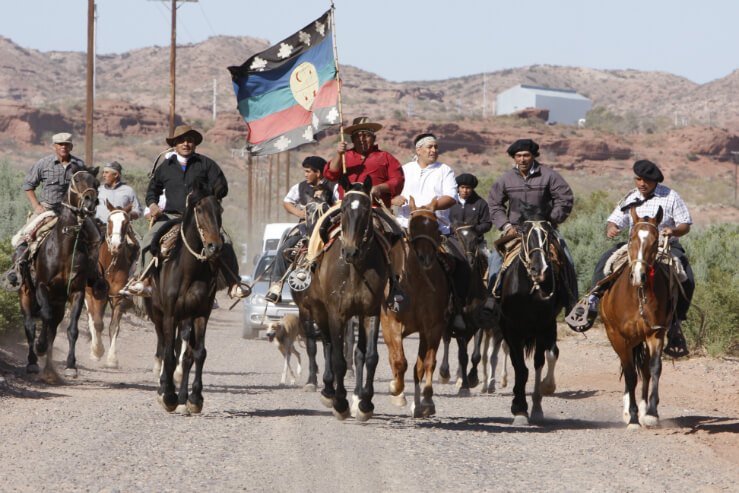
by Deep Green Resistance News Service | Sep 15, 2017 | Indigenous Autonomy
Featured image: James Anaya (former UN Special Rapporteur) visits Mapuche land in Argentina. Credit: Alejandro Parellada IWGIA
by Pamela Leiva Jacquelín, International Work Group for Indigenous Affairs (IWGIA) / Intercontinental Cry
Imagine that your survival depended on defending your right to live where you are standing right now.
Any day, the government could decide to start extracting oil or constructing a highway, exactly where your family goes to sleep every night, without consulting you. Just picture the mine or highway polluting the water you drink and poisoning the soil so completely that crops can’t even grow. On top of this, every day you are pushed to speak a foreign language in a country that endangers your culture and way of life.
This scenario is not fictitious. It is a reality for many of the 370 million people worldwide who identify as Indigenous Peoples. If there could be a simple way to define them, we can agree that they are the living descendants of the pre-colonized inhabitants of lands now dominated by others.
It was only 10 years ago, when Indigenous Peoples around the globe achieved the most substantial victory in a century of demands: the United Nations Declaration on the Rights of Indigenous Peoples (UNDRIP).
The adoption of this declaration has been a breaking point, given the fact that 144 countries reaffirmed that Indigenous Peoples are entitled without discrimination to all human rights recognized in international law. Since 2007, the UNDRIP has guided global efforts to overcome and repair the historical denial of their most fundamental rights, including the most basic right to self-determination.
UNDRIP brought the concept of collective rights to the table. This means that as a group, Indigenous Peoples possess rights that are indispensable for their existence, well-being and integral development as a distinct society. This is perhaps the reason why many find it difficult to relate to their struggles, since dominant societies base policy making and development actions on the protection of individual rights, such as the right to property or privacy.

Maya Weavers holding a proposal for the recognition of collective intellectual property, February 2017. Photo: AFEDES
Representing 5 percent of the world’s population, today many Indigenous Peoples are still excluded from society and deprived of their rights as equal citizens of a state. Living in 70 countries and speaking more than 4,000 native languages, they have gained increasing visibility for raising their voices on aggressive development policies that threaten the world’s remaining ecosystems and the biodiversity that depends on them.
As the world moves fast to explore and exploit these ecosystems to meet increasing consumption, Indigenous Peoples are at the top list of those murdered for defending their land.
Almost 130 environmental activists have been killed so far in 2017. Another four are expected to be killed in the next week.
This global trend is not a coincidence. Indigenous territories are the richest in biodiversity and today more than ever they are becoming the new battleground for human rights and the environment.
“Even though violence against Indigenous Peoples is increasing, the Declaration should be celebrated. Without this Declaration, Indigenous Peoples wouldn’t have a chance to fight”, describes Julie Koch, Director of International Work Group for Indigenous Affairs (IWGIA).
The main driving force for the global assault on indigenous land is that state governments have largely failed to establish constitutional rights and protections for Indigenous Peoples. UNDRIP provides states with a legal framework to establish these rights and protections.
The increasing rates of criminalization of indigenous leaders and the murder of environmental defenders shows us just how much work states have to do for the Indigenous Peoples of the world. It is also a strong reminder that the world’s Indigenous Peoples are key to saving our planet.
The global trend of attacks on Indigenous Peoples takes different shapes on different continents. Let’s go through some of it.
Latin America: Where the Extractive Agenda Threatens Indigenous Victories
Even though Latin America has a favourable legal framework to rely on, it is often reported as the most dangerous continent for environmentalists. Many of the reported killings were of people trying to combat illegal logging in the Amazon.
It only takes a quick look into Brazil to understand what the fight is all about. Here is where the highest number of environmental defenders have died on Earth. Since 2013, 900 indigenous leaders have been killed for defending their lands, despite legally owning 12.2 percent of the country’s territory and living peacefully in 704 collective territories.
Another eye-opening case is Venezuela, where actually the land demarcation process has only met 13 percent of the cases in the last 17 years, neglecting the urgent call to action stated in the Constitution. Just to make things more complicated, the government recently approved the creation of the AMO (Orinoco Mining Arc) region, a mega mining project that will give 150 companies from 35 countries access to 12 percent of the national territory. Once again, national policies seem to forget how illegal mining has already driven aggressions and threats towards the Yabarana, Hoti and Panare peoples close to the border with Brazil.
The race for water is also affecting Guatemala, where hydroelectric projects are quickly on the rise. Groundwater recharge areas are located on indigenous land and indigenous communities have constantly denounced the theft of river water. Various companies and private landowners illegally divert rivers to sugar cane, banana and palm oil plantations and cattle ranches during dry seasons.
Surprisingly, Bolivia does not escape from this pattern. With a controversial political decision, Evo Morales gave the green light to construct a highway on indigenous land. This development project has for several years been opposed by environmentalists and the indigenous movement since it cuts through Isiboro Sécure National Park and Indigenous Territory (well-known as TIPNIS). The construction of this highway is part of a bigger plan. The highway aims to extend the existing Brazilian-led effort commonly known as IIRSA (Initiative for the Regional Integration of South America). This entails a network of 531 mega-projects that include hydroelectric dams, highways, bridges, and electrical power systems that seek to ease the flow of transportation of soybeans and coca across the region. But the impacts are not only economic. The highway will considerably affect the traditional way of life of three indigenous groups: the Tsimanes, Yuracarés and Mojeño-Trinitarios.
But the fight back seems promising. Indigenous autonomous governments are representing much more than a trend in the region. Self-governance is one of the most significant claims made by Indigenous Peoples in this part of the world and it seems to be on its peak of realization with the two first indigenous governments settled in Peru and Bolivia. The Wampís Nation’s Parliament and the Charagua government took office last year and made their goals clear: they aim to control how to administer the future of their ways of life within the territory they inhabit.

Wampis Nation mapping territory in Peru. Credits Jacob Balzani Lööv
Asia: Where Discrimination Pairs with Militarization
Asia is home to 260 million Indigenous Peoples, making it the most culturally diverse region in the world. The land dispute pattern in this region is significantly worse due to heavy assimilation pressure and violent repression by state security forces. As Indigenous Peoples in other countries, they face the routine denial of self-determination, loss of control over their land and extreme discrimination.
One of the most clear examples of the lack of respect for indigenous land rights is the conflict in the Chittagong Hill Tracts (CHT) region in Bangladesh, where approximately 600,000 Indigenous Peoples live. Ever since the creation of Bangladesh, the elected representatives of the CHT have demanded regional autonomy. Being trapped between demilitarization and displacement, gross human rights have been committed and documented over the last 10 years. The most affected by the conflict are indigenous women. Being under the review of the UN Convention on the Elimination of all Forms of Discrimination Against Women (CEDAW), several reports highlight cases of gender-based violence against indigenous women connected with land grabbing.
Indigenous Peoples and minority populations in the Philippines are also hit by militarization. The “war on drugs” and the fight against Maoist rebels now led by President Duterte has led to many political extrajudicial killings in their communities. Indigenous Peoples are also cornered by the aggressive expansion of monocrop plantations, especially oil palm plantations in Mindanao. Community members from the municipalities of Bataraza and Española in Palawan have reported how their rights had been violated by several companies that continue to expand on community lands with the complicity of government officials.
The situation in Nepal follows the course of aggressive development. During 2016, many protests against road expansion and electricity transmission lines intensified. The common picture that local indigenous communities paint is that bulldozers enter their land to ensure infrastructure developments go according the plan.
Perhaps the most illustrative situation of discrimination comes from Japan. The huge gap in public awareness shows the long lasting effects of systematic discrimination. A national survey released by the government in 2016 showed that 72.1 percent of Ainu people agreed that “discrimination against the Ainu people exist”, meanwhile 50.7 percent of the general public stated that “discrimination does not exist”.
Africa: Where Evictions are Driven by Conservation and Agribusiness
Laws protecting Indigenous Peoples are weak or nonexistent throughout continental Africa. With very little political support and space for critical NGOs and media that can effectively report on human rights violations, conservationist and agribusiness agendas frequently push Indigenous Peoples from their homelands.
In Loliondo village in Tanzania, indigenous communities suffer from a systematic attack that aims to reduce their number of livestock, which is vital for their survival. Increasing tensions and clashes with farmers and ranchers are usually driven by recurrent drought. Another common tactic used by the military is to burn houses, which speeds up illegal evictions.
Just last month, Serengeti National Park and Ngorongoro Conservation Area Authority rangers, with the support of Loliondo police, burned down about 185 Maasai bomas (homesteads). The evictions left approximately 6,800 people homeless, with most of their property destroyed.
Evictions are also a current challenge for Indigenous Peoples in Kenya, where the definition of community lands is not in place to allow the urgent need to formalize land ownership. Earlier this year, drought caused traditional herdsmen to steal pasture from landowners, burning down tourist lodges and grabbing the attention of the world media in the process. Laikipia, meanwhile, has experienced unprecedented grazing pressure and the Maasai have been forced to endure limited access to water. This is not the first time that climate shock has systematically triggered violence over land rights in Northern Kenya. The chain of events is pretty straightforward: when there is no water, no grass grows and pastoralists’ cattle starve to death.
The other side of the coin is that Indigenous Peoples are gaining recognition in the courts. Against all odds, we saw an historic land ruling in Kenya this year in the hands of the Ogiek. The African Court on Human and Peoples’ Rights set a vital precedent, recognizing that as Indigenous Peoples the Ogiek have the right to reparations from the Kenyan government for the suffering they have endured from forced evictions.
We Are All Fighting the Same Fight
If Indigenous Peoples remain unprotected, it will continue to have a direct impact on the shape of our planet and its capacity to sustain life. Many would think this gap has nothing to do with protecting the environment, but it absolutely does.
The fight for indigenous land rights is not just about rights, but about securing a sustainable future for everyone.
If states and corporations fail to protect those who are putting their lives on the line to defend the diversity we depend on, it may only be a matter of time before resource scarcity leads them to turn on everyone else.
Indigenous Peoples have pursued environmental justice since long before climate change became a mainstream issue. Ten years after their biggest victory, it is time we take indigenous land rights seriously to ensure we all continue to have water to drink, air to breathe, and even land to call home.
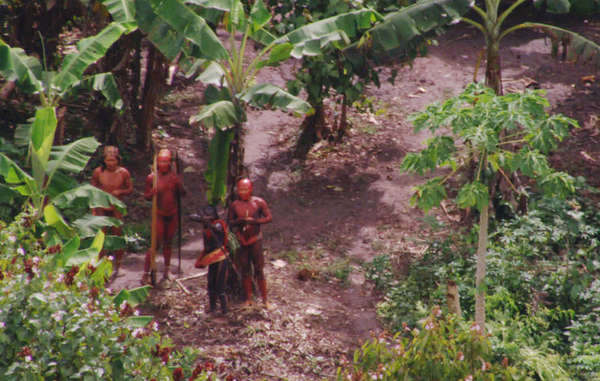
by Deep Green Resistance News Service | Sep 14, 2017 | Colonialism & Conquest, Mining & Drilling
Featured image: A still from aerial footage from 2011 of an uncontacted Amazon tribe in Brazil near the Peruvian border. © BBC/FUNAI/Survival
by Survival International
Brazilian Indians have appealed for global assistance to prevent further killings after the reported massacre of uncontacted tribespeople, and have denounced the government cuts that left their territories unprotected.
Paulo Marubo, a Marubo indigenous leader from western Brazil, said: “More attacks and killings are likely to happen. The cuts to FUNAI’s funding are harming the lives of indigenous people, especially uncontacted tribes, who are the most vulnerable.” (FUNAI is Brazil’s indigenous affairs agency).
Mr. Marubo is the leader of Univaja, an indigenous organization defending tribal rights in the Uncontacted Frontier, the area with the highest concentration of uncontacted tribes in the world.
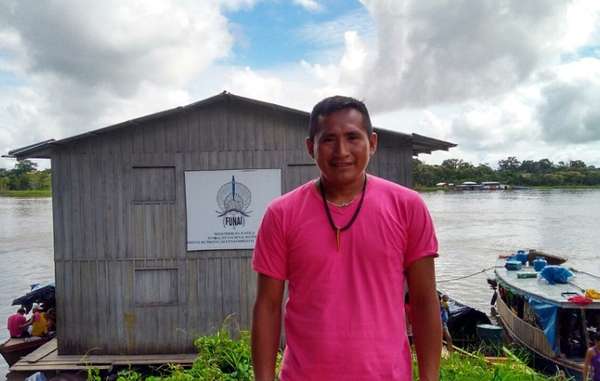
Paulo Marubo, leader of a Javari Valley indigenous organization from the Uncontacted Frontier. © Amazonas Atual
COIAB, the organization representing Indians across the Brazilian Amazon, denounced the massive cutbacks to FUNAI’s budget that has left many tribal territories unprotected:
“We vehemently condemn these brutal and violent attacks against these uncontacted Indians. This massacre shows just how much the rights of indigenous peoples in this country have been set back [in recent years].
“The cuts and dismantling of FUNAI are being carried out to further the interests of powerful politicians who want to continue ransacking our resources, and open up our territories for mining.”
Unconfirmed reports first emerged from the Amazon last week that up to 10 uncontacted tribal people had been killed by gold miners, and their bodies mutilated and dumped in a river.
The miners are reported to have bragged about the atrocity, whose victims included women and children, in a bar in a nearby town. The local prosecutor’s office has opened an investigation.
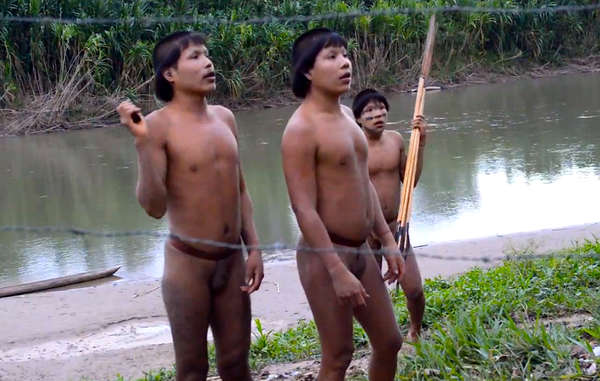
These Sapanawa Indians made contact in 2014. They reported their community had been attacked, and so many members of the village killed that they could not bury the dead. © FUNAI/Survival
The alleged massacre was just the latest in a long line of previous killings of isolated Indians in the Amazon, including the infamous Haximu massacre in 1993, in which 16 Yanomami Indians were killed by a group of gold miners.
More recently, a group of Sapanawa Indians emerged in the Uncontacted Frontier, reporting that their houses had been attacked and burnt to the ground by outsiders, who had killed so many members of the community that they had not been able to bury all the bodies.
All uncontacted tribal peoples face catastrophe unless their land is protected. Survival International is campaigning to secure their land for them, and to give them the chance to determine their own futures.
Survival’s Director Stephen Corry said: “The decision by the Brazilian government to slash funding for the teams that protect uncontacted Indians’ territories was not an innocent mistake. It was done to appease the powerful interests who want to open up indigenous lands to exploit – for mining, logging and ranching. These are the people the Indians are up against, and the deaths of uncontacted tribes won’t put them off. Only a global outcry can even the odds in the Indians’ favor, and prevent more such atrocities. We know public pressure works – many Survival campaigns have succeeded in the face of similar odds.”











































